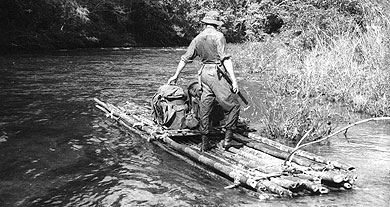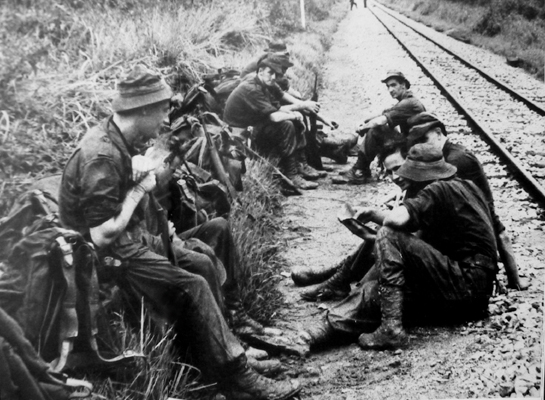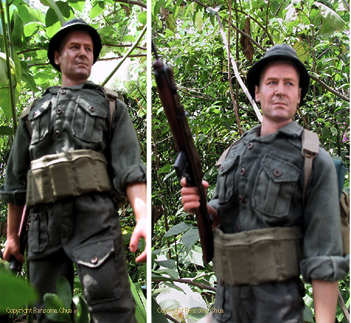Malayan Scouts SAS 1950’s – (July 2006 Project)

Still attired in the 1944 type British jungle shirt and trousers, this trooper wears the Indian JG (Jungle green) jungle hat - a design that was to set the trend for all postwar jungle hats. The style of wearing the bandolier at the waist was not common only to the Malayan Scouts. This project, completed in 2006 has a repainted headsculpt, but for some perverse reason at that time, was photographed with neck and wrist joints exposed; these have all been given a little dash of Photoshop post-production effects for the enjoyment of viewers!
During the Malaya Emergency, the British Army witnessed the rebirth of a very specialized unit, the SAS. Disbanded shortly after the end of the Second World War, the specialists of the SAS returned to the fold in 1950 when General Sir John Harding, Commander-in-Chief Far East decided he needed independent advice from an expert in jungle warfare.
The man he called in was Major “Mad” Mike Calvert , a jungle warfare veteran of the Burma campaign during the Second World War. Calvert was widely known as “Mad Mike” on account of the degree to which he led several risky counter-attacks against encircling Japanese forces in person. On March 17, 1944 he led a bayonet charge which degenerated into a free-for-all, which Calvert later described as “just like an officers’ mess guest night”. On April 13 he commanded a much larger attack involving most of the brigade. He learned that a friend (Major Ian MacPherson) had been killed and his body left in the Japanese positions, and his Brigade Major had to threaten him with a revolver to prevent him returning alone to retrieve it.
Calvert had also been one of the prime movers in ensuring the SAS ethic hadn’t died out at the end of the war. Calvert went to Malaya with an open brief and spent several weeks touring the country.
At the same time, Lieutenant-General Sir Harold Briggs was sent out as Director of Operations in Malaya. The Briggs plan incorporated several people’s input, including Calvert’s, and focused on interdicting the Communist Terrorists’ food and intelligence by denying them support and freedom of movement. Calvert’s contribution was a force of troops who could live in the jungle for long periods and win the confidence of the aboriginal tribes, control the enemies’ movements and force them into the open where the regular army and police could deal with them.
Calvert was authorized to form his special force, but it was stressed that it would be only for the duration of the emergency, under Far East Command and with nothing to do with the SAS territorial set-up in Britain. The new formation was called the Malayan Scouts (SAS).
Calvert’s initial step was to search for volunteers in the Far East, and produced 100 men who formed A Squadron. The second source of recruits was the group of wartime reservists who had been formed to fight in Korea, commanded by Major Anthony Greville-Bell. These highly experienced men arrived in Malaya in January 1951 and formed B Squadron. C Squadron came from Rhodesia where Calvert had picked them on a quick visit from 1,000 volunteers.
The Malayan Scouts set up base camp at Kota Tinggi near Johore and Major John Woodhouse started an ad hoc induction programme. Calvert was an enthusiast for practice using live rounds and he was under pressure to get results quickly. However, the Malayan Scouts were not subject to proper selection procedures and never lost an early reputation for poor discipline. Calvert’s exertions meant that he was invalided home in 1951.
Life in the Malayan Scouts – An account by Allan Glass
“What did we actually do in the Malayan Scouts? The SAS is a secret organisation so I will confine my remarks on operational successes and failures to a bare statement of our role. It was to undertake deep penetration operations in order to locate and destroy terrorists no matter where they tried to conceal themselves. This we did,with little fuss and less credit than appears to be the form today.
I can however say something about our life on operations and our difficulties. My first operation was as the nominal second-in-command to a Troop Commander, Sinclair-Hill (known inevitably as Bukit-Sinclair [Bukit is Malay for hill]), a charming officer who led the troop most effectively.
We were on operations for one hundred and four days,which was at that time the longest operation carried out by any unit in Malaya. We completed detailed patrolling of a vast area of Pahang. We were supplied by air following the air drop routine which I had already learned during my time with the jungle squad.
I remember that our kit new when dropped would virtually drop off our backs within a week. We often wondered how the men in General Slim’s Army managed to cope in Burma. One of the things that has remained with me since those days so long ago is a hatred of vegetable salad by Heinz. However much one hated such tinned food one could hardly throw it back at the aircraft. Unfortunately this detestable mixture was one of our Commander’s favourite dishes. Enough said!
Communications were very primitive by today’s standards. We were still using morse and messages were put into code and then transmitted by pedal trans-receivers. These were really out of date even compared to the 68 sets used by other units but had the advantage of much greater range. I always had great respect for our SAS signallers operating under such awful conditions. At least we were able to communicate. I remember during a month long operation in 1949 in Kampar we had to borrow two Gurkha signallers as the Police then did not have mobile radios.
When out on a long patrol I used to sleep in a small one man hammock with a waterproof top and mosquito proof sides. As a three man patrol we did not have the man power to mount night sentries after the day’s march so we surrounded our camp site with effective booby traps and were comparatively safe – provided we remembered were they were!
Although we had other things to think about there were some quite beautiful things to see in the jungle. I remember particularly some of the rivers and small lakes. Not to mention wildlife. One three man patrol came back to base and said they had seen a pride of tiger cubs. When asked what they did they said that they had kept very quiet and just watched”as discretion was a sign of maturity – and survival” A wise,safe decision. “

I modified BBi's Royal Marine Allen's boots to create these canvas rubber jungle boots. Seared away the details at the top and lower sides of the boots with a heated metal burnisher (from the good old days when one uses a burnisher to burnish those Letraset type transfers). The rubber toecap was easily created by delineating the upper edge with the heated edge of a papercutter blade or whatever. I can't for the life of me recall whether there were grommets or clasps at the upper part of the boot (perhaps there were in some variants)! But I remember the distinctly unjungle-like green colour of the canvas.
The rundown for this figure (Dragon’s Graham – Falkland War)-
Uniform: BBi’s Burma Campaign British Jungle Fighter- can’t remember his name!
Jungle hat: 21st Century; possibly Mike Force black boonie hat repainted Jungle Green
Web belt: Dragon – modified with grommets to attach the 1944 water bottle
Bandolier: 21st Century
US M1 carbine: BBi
Boots (customised): BBi’s Royal Marine
Backpack (re-dyed): BBi
Parang/Machete: BBi
Post-production work: Neck and wrist joints photoshopped
Research work
While researching on the Malayan Scouts, I came upon this account by Derek Mc Farland Jr at Special Forces Roll of Honour website. He states of his late father who was a Malayan Scout:
“My father served in Malaya in 22 SAS and passed away recently, His name was Derek Mc Farland.
I have come into possesion of numerous black and white photographs of him, his squad and the local trackers they employed whilst on operations. Some are obviously quite rare, small photos showing the men on patrol, in the sgts mess and there are a few of the ‘scouts’ whom he always spoke very highly of.
He told me a few tales about some of his operations, for example he was the only serviceman who canopy jumped with a dog attached to his harness, he said he would rather have his dog and a tracker than a whole regiment with him!!!”
Images by courtesy of Special Forces Roll of Honour














Past project, but great now too.
Thanks Jordi, I’m planning more oldie Blast from the Past! projects.
i was an x soldier ( malaysian) who served my country and i have the deepest respect of the SAS when they fought the communists in Malaya then and the indonesian infiltrators during the 60s.
Yes, those were the wild and nasty times then. Thanks for visiting!
I was a member of sinclair Hill,s long patro..Your site certainly brought back memories
Thanks for your comments… I hope the memories didn’t include leeches, snakes and wild boars!
Mike Sinclair-Hill was my business partner and good friend from 1965 up till his death. I had the greatest respect for his integrity, straight talking and his ability to always see the better sides of all he met. I knew little of his time in Malaya, he never spoke of that part of his life but his sense of responsibility to the people he was involved with in business was paramount. I grieved when he died for he was a presence in my life I valued greatly.
Does anybody remember my brother Pat Slevin? Served in India, Palestine, Korea and Malaya, with the Scouts
I was in the Scouts when they were formed but regret cannot remember. Which squadron was he in and was he based at Dusan Tua ?
Hello John. I am in the process of getting his service history from records but he was airborne so I think he was in b squadron.
Hello John, I ‘mind’ Rocky Blake who would be delighted to hear from you, all the best, H.
im an exvat69 member of 1977-1993 and remember well visiting british SAS members on a training exchange. The SAS head over here every year without fail..after all vat69 was created by the 22nd SAS and we are always proud that the 22nd SAS allowed us to have the same sand colour berets as them.
My late dad served twice in the Malayan conflict with the SAS, I will dig up his papers with the details, I have pictures as well, thanks for the web page, very intresting.
Anyone remember my great uncle Jim (Jimmy/James etc) Bull?????????
I still ‘mind’ Rocky Blake who would appreciate any info on survivers of the Scouts, especially of those 50 odd ‘B’ Sqn, that jumped with him in Feb, 1952. One of his mates’ was Geordie Hudson, who he would be delighted to hear about but all info welcome. Cheers, H.
I am trying to find out about my fathers time in the army, he said he was in scouts in the 50’s his name is HAYDN JOHN DAVIES
Thanks
My granddad was in Malaya around the mid-50’s, I think he was part of 22 SAS D Squadron on detachment from the Royal Ulter Rifles. His name was Pete McWilliams or ‘Mac’ to his mates…..does anyone remember him?
My Dad too was in 22 SAS, your photos are so like his 🙂 Sadly Dad passed away last month so I can’t ask him about names listed here, but he was Pat Travers, sometimes known as Doc?
hello erin
Sadly my dad has dementia so what he can remember is bits and pieces, he just smiles at the pictures now
My uncle Alexander Campbell Lillie served in the SAS in the 1950’s and served in Malaysia. Does anyone remember him? would be great to chat and hear stories of his time serving for his country. 🙂
Please can you varify if there was a Sargent Major Harald James Frayne as part of the Malayan Border Scouts SAS detatchment in the early 50’s My parents seperated and my mother told me that my father was there. I do not have any photo’s of him and realy didnt know as thhe split happened when I was very young.
I was in HQ Squadron 1950/52 Served as intelligence sergeant. Did two major ops the 108 day effort with Sinclair/Hil, and with the Rhdesians on their first op. J.Mansfield